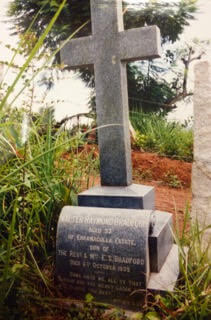 PLANTATION DESPAIR
PLANTATION DESPAIR
Nostalgia for the Raj often presents a glamorous picture of British life in India before Independence in 1947, but careers outside the major cities could be challenging and lonely. BACSA member and historian Dr Avril Powell tells us a tragic story about a relative.
‘On a recent visit to Kerala I visited my uncle’s grave in a tiny cemetery perched on a hillside overhanging the precipitous Western Ghat highway. St John’s Church is situated where the road connecting the coast with the hill country, after an almost vertical ascent, and many breath-stopping hairpin bends, flattens out to the small town of Vyathri, and to the green vistas of the tea plantations beyond. Belonging now to the Church of South India, the cemetery contains only half a dozen pre-Independence graves. BACSA granted £400 some twenty years ago to prune the undergrowth and to repair its perimeter fence (apparently in order to keep the local goats ‘out’, or perhaps, according to correspondence at the time, to keep them ‘in’). Consequently, when my niece visited shortly afterwards, the graves were in excellent condition. Sadly things have deteriorated since: the chapel roof leaks, the stone edging of my uncle’s monument has been removed, and the inscription is half-obscured. (see photo below) I met the minister, the Reverend Anil David, who, fairly new to the parish, knew very little about the history of the cemetery, but who unlocked it for me and expressed interest in my quest.
‘This quest was to explore the background to a sad tale of utter despair with plantation existence, followed by suicide just as the Second World War commenced. For on 6 October 1939, my uncle, Walter Raymond Bradford, aged 32, and apparently among the ‘most promising younger members of the planting managership’, shot himself in his bungalow on the Chembra Peak tea estates, after first shooting his horse. The latter action was not as unusual as it may sound, as according to local informants, planters often acted so, even when merely leaving a region, for fear others might ill-treat their steeds. As for the suicide, family letters suggest that such despondency was the culmination of a number of causes. Born in Upper Burma, the son of a Methodist missionary, it seems that my uncle was directed to a plantation career for lack of alternative career prospects, following an indifferent record at a famous Methodist boarding school in Britain (a case, most probably, of what would now be recognised as dyslexia). By the time of his suicide, thirteen years later, having had only one home leave, he had nevertheless advanced from assistant manager to manager of two tea estates in the Chembra Peak region of present day Wyannad district. But his letters emphasize the extreme loneliness of such plantation postings, an impression certainly supported by memoirs from other tea plantations in India, especially when marriage was discouraged until ten years’ service was complete. In his case, at least one ‘jilting’ by a proposed bride left him still a bachelor in 1939. Letters written after his suicide by his general manager, showing great empathy for his situation, suggest that matters reached desperation point when, on the declaration of war, unlike many ‘other fellows of his age’ who were called up for war service, he was passed over on the practical ground that his presence was vital, war or no war, to ensure the flow of tea to the motherland.
The local planters’ association organized an immediate burial, with one of their number officiating in a ‘lay’ ceremony. War conditions made correspondence with the family in Britain very difficult, but eventually a headstone and inscription were provided, with donations from local planters. Present family members are now relieved to know that their relative was buried in consecrated land (although at that date suicides were usually buried in unconsecrated graves), but as a child I was never told of the manner of the death, and not until my mother’s death did I read the locked-away correspondence. Yet, the shock of the event in Wyannad itself was such that, sixty years later, the children of estate workers could relate details (such as the shooting of the horse) handed down to them by their parents.
Written records and oral testimonies are too sparse to contemplate a full memoir of a planting career suddenly cut off, and a sad one at that. However, my recent stay at a nearby ‘homestay’ in the heart of the plantations surrounding Chembra Peak, and the help of my host, Mr Victor Dey (awarded a life-membership by BACSA for his earlier services to cemetery research in Kerala), have stimulated an interest in the wider question of the under-researched lives of the many others occupying the ‘subaltern’ stratum of British, and increasingly Indian, assistant-managership on such plantations during the final years of the Raj. There has been considerable study recently of social aspects of plantation life in Assam and Sri Lanka, but Wyannad, in the remote north-east of Kerala state, has had scarcely any attention (although Heather Lovatt’s evocative history of a neighbouring Kerala district, in Above the Heron’s Pool, published by BACSA, provides a parallel context). I welcome contact with any BACSA members who have knowledge of plantation conditions during the inter-war years in Kerala in general, but in this particular district in particular.
